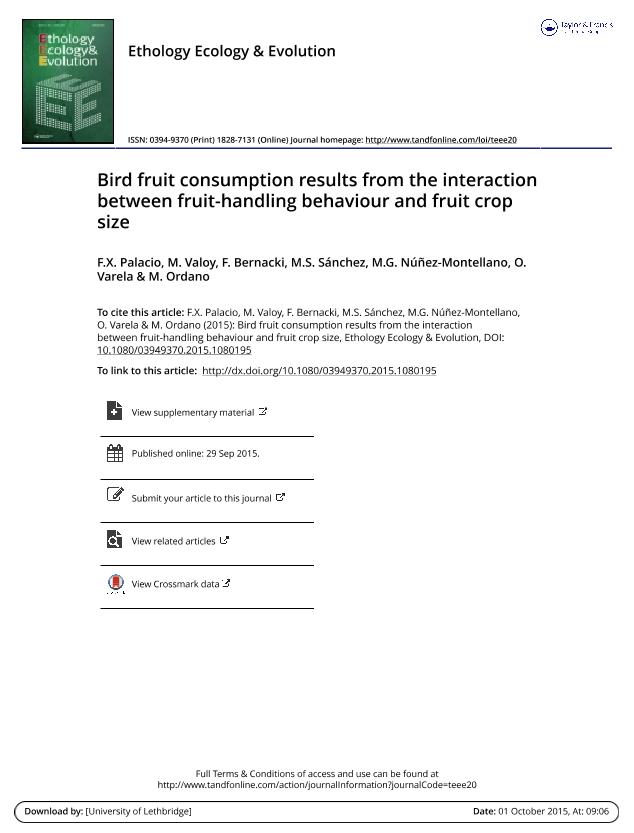Artículo
Bird fruit consumption results from the interaction between fruit-handling behaviour and fruit crop size
Palacio, Facundo Xavier ; Valoy, M.; Bernacki, F.; Sanchez, Mariano Sebastian
; Valoy, M.; Bernacki, F.; Sanchez, Mariano Sebastian ; Nuñez Montellano, Maria Gabriela
; Nuñez Montellano, Maria Gabriela ; Varela, O.; Ordano, Mariano Andrés
; Varela, O.; Ordano, Mariano Andrés
 ; Valoy, M.; Bernacki, F.; Sanchez, Mariano Sebastian
; Valoy, M.; Bernacki, F.; Sanchez, Mariano Sebastian ; Nuñez Montellano, Maria Gabriela
; Nuñez Montellano, Maria Gabriela ; Varela, O.; Ordano, Mariano Andrés
; Varela, O.; Ordano, Mariano Andrés
Fecha de publicación:
01/2017
Editorial:
Taylor & Francis
Revista:
Ethology Ecology & Evolution
ISSN:
0394-9370
Idioma:
Inglés
Tipo de recurso:
Artículo publicado
Clasificación temática:
Resumen
Bird foraging behaviour is a major factor involved in mutualistic interactions of fleshy-fruited plants. Despite much research, we still lack quantified demonstrations of how fruit display traits affect fruit removal behaviour. Although the fruit crop size hypothesis proposes a general mechanism for fruit trait selection, it overlooks the fact that distinctive bird behaviours in a bird assemblage would have different effects on fruit crop size. Here, we show that the relevance of fruit crop size for bird fruit consumption is driven by two basic components of fruit foraging behaviour: fruit handling and residence time. We assessed bird fruit-eating behaviour (fruit consumption, fruit handling and residence time) and its relationship with fruit crop size, taking into account body size and spatial focal context (conspecific neighbour density and distance to the forest edge from individual plants) in a population of Vassobia breviflora (Solanaceae) in Tucumán, Argentina. At the assemblage level, fruit consumption was positively related to fruit crop size and residence time, and the interaction between fruit crop size and residence time depended on fruit-handling behaviour. At the functional group level, both gulpers and pulp consumers showed a positive relationship between fruit consumption and residence time. However, gulpers showed a negative interaction between fruit crop size and residence time, while pulp consumers showed no interaction. At the species level, fruit consumption by Turdus rufiventris (gulper) was positively related to fruit crop size, whereas fruit consumption by Thraupis sayaca and Zonotrichia capensis (pulp consumers) depended positively on residence time. Essentially, gulpers spent short residence times in plants with larger fruit crops, whereas pulp consumers spent long residence times in plants regardless of fruit crop size. The segregation between fruit-eating behaviours and their relationship with fruit crop size suggests that bird functional groups (i.e. gulpers and pulp consumers) would shape fruit display traits with different intensities.
Archivos asociados
Licencia
Identificadores
Colecciones
Articulos(UEL)
Articulos de UNIDAD EJECUTORA LILLO
Articulos de UNIDAD EJECUTORA LILLO
Citación
Palacio, Facundo Xavier; Valoy, M.; Bernacki, F.; Sanchez, Mariano Sebastian; Nuñez Montellano, Maria Gabriela; et al.; Bird fruit consumption results from the interaction between fruit-handling behaviour and fruit crop size; Taylor & Francis; Ethology Ecology & Evolution; 29; 1; 1-2017; 24-37
Compartir
Altmétricas



